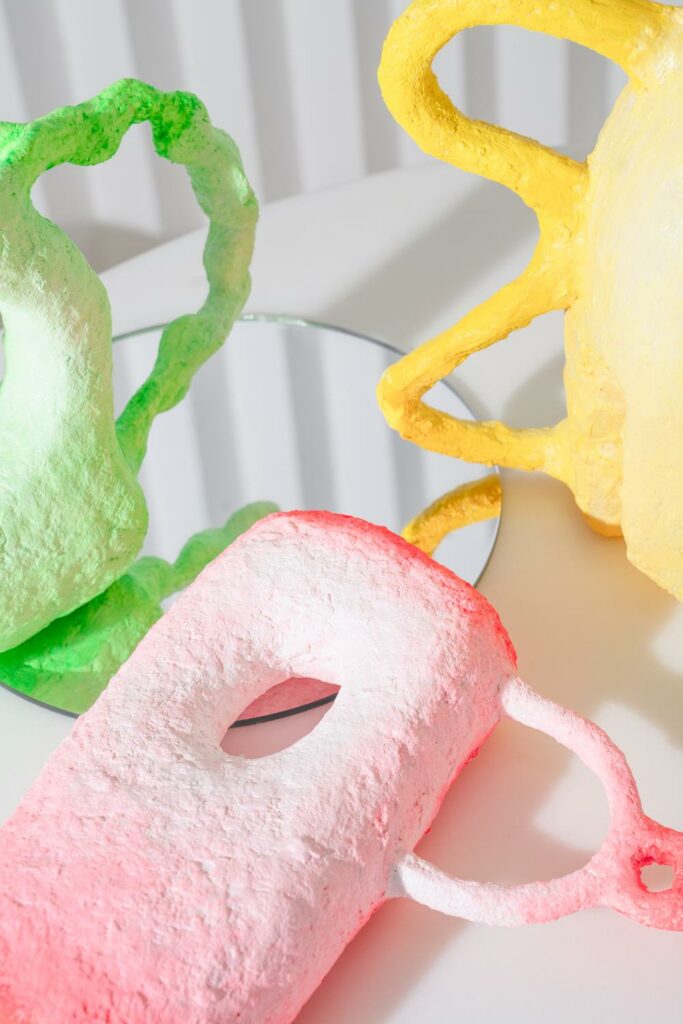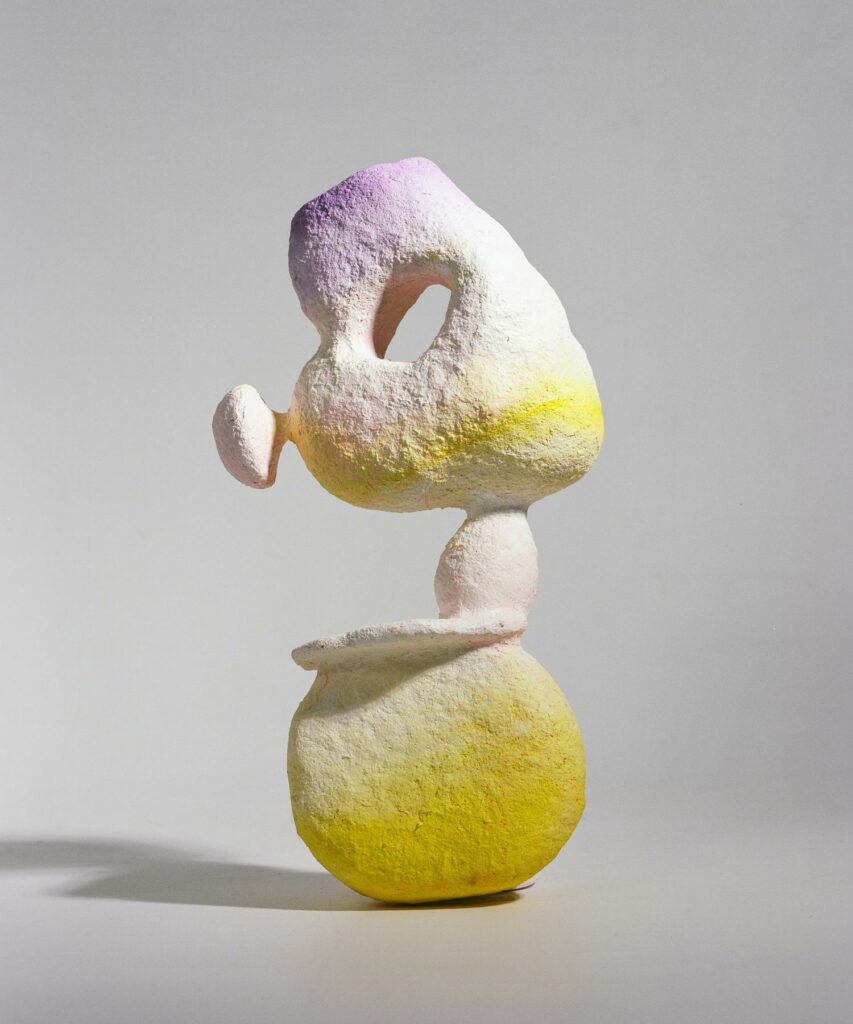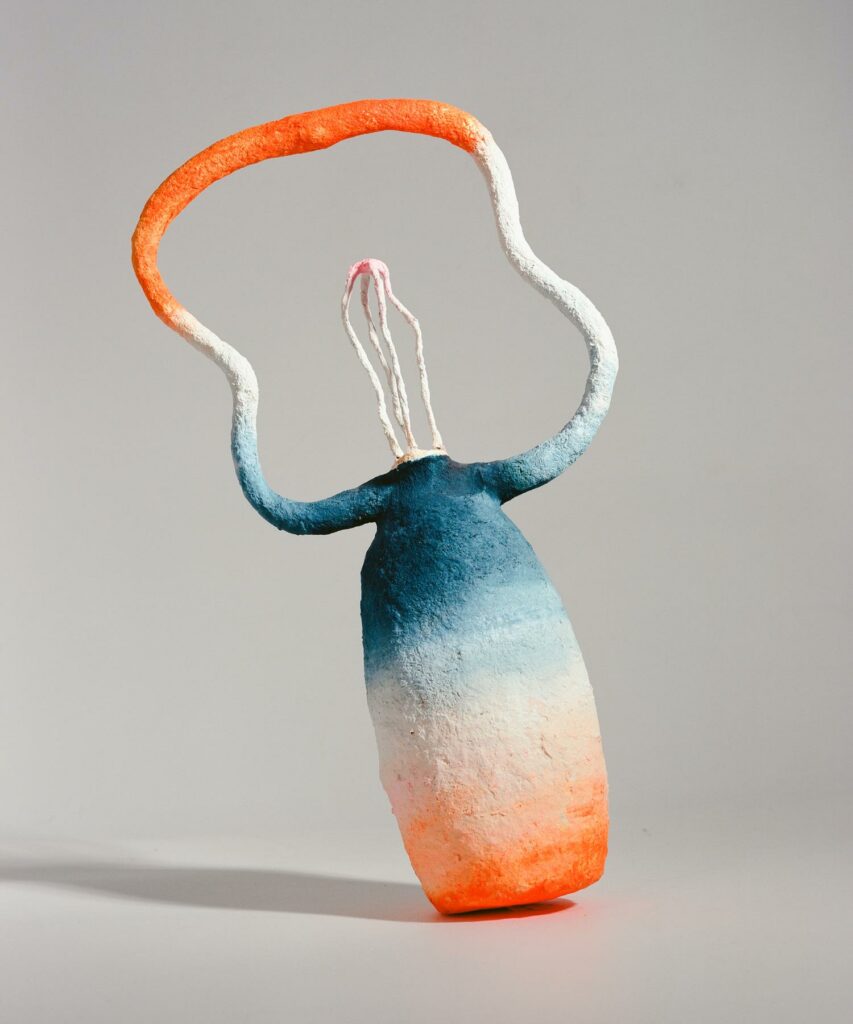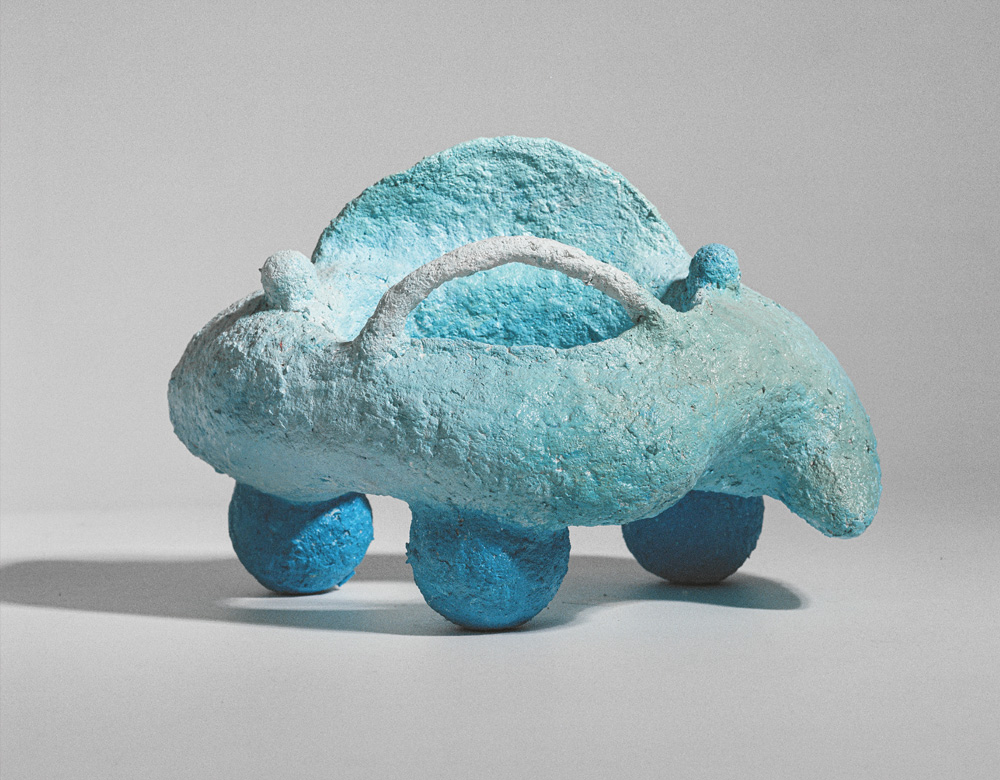What drew you to work with paper-mâché and pulp-based composite materials?
The feeling that paper-mâché gives me is primitive, simple, light, and highly malleable. The uncontrollability during the process of making pulp also brings me a lot of freshness. Compared to traditional clay sculpture, the natural texture that forms after the pulp dries has always fascinated me. It is precisely this texture that brings a sense of clumsiness and handcraft that I intend to express.
I enjoy exploring and researching materials, attempting to gradually “functionalize” the work and blur the boundary between sculpture and product. The work is “squeezed” between the two. Through understanding color, structure, and current popular culture, I continuously advance the development of my work while maintaining a certain degree of unpredictability.

How did your experiences at Chelsea College of Art and Design and Glasgow School of Art shape your approach to art?
During my studies, I mainly researched various materials and mixed media. For example, cement, resin, and plaster were common materials in my past works. The creative thinking in the West is very different from the art that I grew up with in China. This period of study gradually made me realize that I wanted to do something different. Or rather, I wanted to understand and explore myself more deeply, expressing my perspective on life.
Can you walk us through your creative process, from initial concept to finished piece?
At first, I would roughly sketch some drafts. These shapes usually stem from my pursuit of nature and organisms. However, I usually do not directly translate these sketches into three-dimensional sculptures. For me, the images bring new experiences, maybe through lines or colors. Next, I build models based on my memories of the sketches. I feel this is a slow and interesting process where I gradually establish a personal relationship with each piece through a dialogue with it. I often start with a typical shape and gradually distort it into a character. It might not be about “looking like” something specific but rather about evoking a certain feeling. During the process, I layer and shape the pulp until I find a satisfying form. Finally, I paint the dried white pulp. The colors enhance the realism of each character, making them feel close and endearing, providing me with a lot of imaginative space.

How do you choose the colors and forms for your sculptures?
I want to incorporate elements of nature, such as fossils, organisms, soil, or seeds. However, I do not aim to completely replicate nature. Instead, I use highly saturated colors and gradient techniques to express a fresh, easily captured, and fluid feeling. To me, color signifies vitality and emotion. Colored pieces seem more alive, as if they are breathing. This is a crucial part of what I want to express. Bright colors are cleaner, purer, and more dynamic.
I want to explore the feelings that “containers” evoke, blurring the boundaries between sculpture and containers. This reflects the concepts of enveloping, surrounding, and containing, emphasizing the subtle imprints of individual existence and the dialogue between self and nature. The somewhat dazzling changes in color and shape break the stereotypical perceptions of sculpture and vessels, inspiring the viewer’s poetic imagination and subconscious personal experiences.
Can you elaborate on the concept of “upcycling” in your art and why it is significant to you?
The concept of “upcycling” is essential in my art. My sculptures aren’t just about creating art; they also emphasize the importance of recycling and reimagining the endless possibilities of discarded materials. To me, upcycling is about turning discarded or seemingly useless materials into new, valuable creations. This aligns with my beliefs in sustainability and environmental awareness. By reusing materials that might otherwise become waste, I aim to highlight the beauty and functionality that often lie hidden in things we overlook or throw away.
In my work, I use pulp made from recycled paper. This not only gives new life to materials that might otherwise end up in a landfill but also brings a unique texture and character to my sculptures. The process of turning old paper into pulp and sculpting it into new forms is a metaphor for transformation and renewal. It reflects the idea that everything has the potential to be reborn and reimagined.
Upcycling also allows me to create art with unique qualities and stories. Every piece of recycled paper I use has its own history and background, which adds depth and character to the finished sculpture.

What has been the most memorable response or feedback you have received from an exhibition?
One of the most unforgettable pieces of feedbacks I received at an exhibition came from a young child. As he looked at my sculpture, he exclaimed loudly, “I want to live inside this!” I was very surprised; it showed that my work can touch the imagination and emotions of audiences of different ages. The child’s imagination enlarged what was originally a small sculpture, giving the work infinite possibilities beyond itself. This has inspired me to explore a larger and more enriching artistic world in my next steps.
How do you feel your sculptures reflect your own personality and experiences?
My artworks often take on an abstract or semi-abstract form, reflecting my pursuit of expressing inner emotions and feelings. I tend to explore the relationship between form and color, seeing these elements not only visually but also as expressions of emotions and spirituality. This abstraction allows for multiple interpretations of my work, and I hope each viewer finds resonance and understanding in it. As a female creator, I believe my artworks have certain gender inclinations—they can be beautiful, sensual, robust, rational, and infinitely charming. By integrating art with functionality or everyday life, I aim to reflect on and explore the role that art can play in daily life.

Do you see a connection between your sculptures and any broader environmental or social themes?
Through the use of renewable materials and emphasizing sustainable creative methods, my artworks directly reflect a concern for environmental protection and sustainable development. This practice is not only about artistic expression but also a way to actively support environmental conservation through practical action. My artworks often explore the relationship between humans and nature, or delve into the roles and identities of humans in modern society. Through abstract forms and multi-layered visual interpretations, I aim to stimulate viewers’ reflections on the complex interactions between nature and humanity.
Website | Instagram





Leave a Reply
You must be logged in to post a comment.